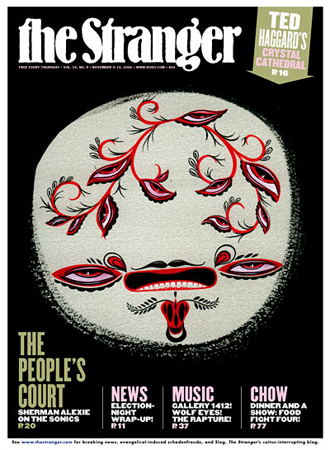 All of a sudden it’s coming from everywhere at once. In one ear, an iPod recording of street sounds from Brooklyn—trains passing, distant shouts. In the other ear, fresh voice mail from a colleague. Straight ahead, an old photograph of this place, the Panama Hotel, where Japanese families once dropped off their life’s belongings on the way to internment camps. Across the room, chatter between a barista and a regular, veiled by delicate music. Underfoot, the basement bathhouse that closed 56 years ago, its pitted marble baths and numbered wooden lockers for Japanese workers.
All of a sudden it’s coming from everywhere at once. In one ear, an iPod recording of street sounds from Brooklyn—trains passing, distant shouts. In the other ear, fresh voice mail from a colleague. Straight ahead, an old photograph of this place, the Panama Hotel, where Japanese families once dropped off their life’s belongings on the way to internment camps. Across the room, chatter between a barista and a regular, veiled by delicate music. Underfoot, the basement bathhouse that closed 56 years ago, its pitted marble baths and numbered wooden lockers for Japanese workers.
I suppose every moment could be sculpted this way, as a series of distant events and influences crossing, if only the center point were receptive enough. That is one premise of The East River Project by the artists Gretchen Bennett and Yann Novak. They’ve drawn me to this convergence by overlaying sounds and sights from Williamsburg, Brooklyn—along the East River—on Seattle’s International District. Out the front door of the Panama Hotel are two faded orange stencils that resemble the arcane marks of city workers, made in the same construction marking paint. According to a map of the district with a legend of the six different stencils Bennett used in the project, these two are recognizable as the husky heads of junkyard dogs, even though at this point, only two pairs of ears remain on the blacktop as a marker that Bennett was here.
“It reminds me of Masaryk’s shoes,” Bennett says on a foggy morning. “When the Nazis destroyed the statue of the Czechoslovakian president, they left his shoes, because they couldn’t blast them out of the side of the mountain.”
Bennett isn’t equating a meandering adventure through the ID with the rocky determination of an entire strain of European underdog nationalism. She’s flagging the unheard speech of incidental monuments. And the ID, where both she and Novak live, is full of incidental monuments: the Spic n Span Cleaners sign “With Liberty and Justice For,” the recorded bells playing at the door to a Buddhist temple, the ghost signs for Chop Suey Chow Mein and Dancing.
Bennett is a Northwest native, but for several years she lived in Brooklyn, across the East River from the Lower East Side of Manhattan, and, still longing for the “fast-moving current of culture you’re a part of there,” goes back often. The East River Project has three locations: Williamsburg in Brooklyn, Seattle’s ID, and the web. The tour begins in the neutral territory online, with a downloadable MP3 and map of the streets involved. There are no instructions and no explanations about where the symbols appear, where they’ve come from, or what their placement means, if anything. The tour superimposes one neighborhood on top of another, like a double-exposed photograph.
When John Cage made Imaginary Landscape #1 in Seattle in 1939, it had nothing to do with being outdoors. It made a new nature by stitching together layers of sonic experience: the true (live percussion), the false (recorded sound), and the trash (noise). The East River Project also combines three elements: Seattle now, Brooklyn then, and temporary street marks indicating something beyond themselves, some system that only a few understand. Only Bennett knows the system, with its index of chosen locations, including her favorite spots, and symbols—the junkyard dog, two standing pit bulls fighting, a sitting pit bull in profile, Brooklyn’s iconic shuttered Domino Sugar factory, a television shot of the plane that exploded in 1988 over Lockerbie, Scotland, and the message “Attention Vagabond” that she once saw scrawled under the Williamsburg Bridge. But the tour is not a puzzle. It’s not a scavenger hunt where you find what you came for. It is a scattered alphabet that can only produce partly decipherable words. Pleasurable confusion keeps you going.
“Is that—?”
I’ve already asked Bennett not to answer my questions, so she doesn’t respond.
We stop, and I, still wearing the earbuds, look up, waiting to see a plane pass overhead. Except I don’t know if it’s in the sky or in my ears. I’ve already been mixed up about birds and trucks.
The sound fades. I keep gaping. Bennett finally steps in to reassure me: It was up there, you just couldn’t see it.